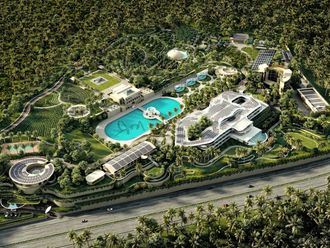New Delhi: Jindal Power Ltd, a unit of India’s biggest steelmaker by market value, plans to spend $7.7 billion (Dh28.27 billion) on hydro-electric projects over the next decade as a coal shortage forces utilities to cut dependence on fossil fuels.
The generator, which shelved a share sale plan announced in 2009, will invest Rs427 billion (Dh28 billion)in the northeastern state of Arunachal Pradesh to install 6,100 megawatts of capacity, Jayant Shrinivas Kawale, managing director for hydro and renewables, said in an interview in New Delhi.
The company expects to get government approvals for its first water-based electricity project by the end of the year, he said.
“These projects will strengthen our portfolio,” Kawale said.
“The biggest positive for us will be that for the next 45 years, we will have plants that run steady without troubles coal-fired ones face.”
The company’s first unit may start producing power in seven years, he said.
Jindal, GMR Infrastructure Ltd and Lanco Infratech Ltd are expanding into hydro projects as a hedge against inadequate fuel supplies in the nation where 56 per cent of the power is generated using coal.
Apart from the unit of Jindal Steel & Power Ltd, at least five companies have announced capacities worth $16 billion of investments to take advantage of incentives offered by federal and state governments for the clean energy.
Power outages
A shortage of the fuel used in thermal plants is threatening to worsen blackouts in Asia’s third-biggest economy, where power is vital for reviving growth from the slowest pace in almost a decade.
About one in four Indians lives without electricity, according to the UN.
NTPC Ltd, the nation’s biggest generator, last week said it scaled back plans to add coal-fired capacity by 42 per cent for the five years ending 2017.
Prime Minister Manmohan Singh is offering concessions to promote cleaner alternatives to counter concerns from environmentalists even as his efforts in February to boost coal supplies to utilities fail.
The government allows hydro operators to sell 40 per cent of their output at market rates, unconstrained by state-administered price controls faced by thermal plants.
Fossil fuels are blamed for global warming as a United Nations Environment Program report on June 6 said current trends in carbon output show the Earth may warm by at least 3 degrees Celsius by 2100 from pre-industrial levels.
Hydro projects account for about 20 per cent of generation capacity, according to data provided by the Central Electricity Authority. The rest is from gas, wind and solar sources.
Worst performer
Parent Jindal Steel & Power rose as much as 1.4 per cent to 443.65 rupees and traded at 441.9 rupees as of 9.34am. in Mumbai.
The stock has slid 31 per cent from this year’s high, making it the worst performer in the 11-member BSE Metal Index.
The company is rated a “buy” by 25 of the 36 analysts who track it, while four recommend a “sell,” according to data compiled by Bloomberg.
Jindal Power’s plans to expand into hydro may distract its focus away from its core thermal business as the investments take a long time to yield results, said Niraj Shah, an analyst at Mumbai-based Fortune Equity Brokers (India) Ltd.
“Their core strength is thermal and they shouldn’t be and can’t be spending on hydro power,” said Shah, who has a buy rating on the parent.
“They should be spending money to complete thermal projects where work is already going on.”
Jindal Power operates a 1,000-megawatt power plant in the central state of Chhattisgarh, and it plans to raise total capacity more than 11-fold to 11,480 megawatts in eight years, according to the company’s website. The New Delhi-based company plans 6,100 megawatts of capacity in hydro, with each megawatt costing 70 million rupees, Kawale said, while a coal-fired capacity costs 50 million rupees typically.
Coal Mines
The government is pushing for about 9,204 megawatts of hydro capacity addition in the five years to 2017, or a 24 per cent increase, according to a new policy draft on the website of the Central Electricity Authority.
Chairman Naveen Jindal, who is also a lawmaker belonging to the ruling Congress party, has acquired coal mines abroad to feed his thermal and steel plants as the government estimates the fuel shortfall to widen 40 per cent to 192 million tonnes in the year ending March 31.
Jindal owns three fields in Mozambique, Indonesia and South Africa with combined reserves of 1.5 billion tonnes.
Profit at the parent company rose 5.6 per cent to a record 39.65 billion rupees in the 12 months through March. Earnings have lagged behind analyst estimates in each of the past three years.
Low costs
Jindal Power has yet to decide on the time for its initial public offering, deputy managing director Sushil Maroo said last year, without elaborating.
The company planned to raise 72 billion rupees when it announced the proposal on December 29, 2009. Jindal Steel’s shares have since slipped 4 per cent.
“There’s incentive now to push for these hydro projects as access to coal is becoming a bigger problem,” said Vijaykumar Bupathy, an analyst at Spark Capital Advisors in the southern city of Chennai.
“The running costs are very low compared to thermal plants after considering the risks and delays involved in building the plants” that include flash floods and rehabilitation of people.
Heavy rains, delays with land acquisitions and environmental approvals have crimped coal output in India, with the hurdles exacerbated by inadequate transportation networks. Coal India Ltd, a state-owned company that accounts for about 80 per cent of the national output, has failed to sign supply contracts, saying it could meet only 50 per cent of the demand even after Singh ordered penalties in February.
Singh is planning to spend $400 billion in the five years ending March 31, 2017 to add 76 gigawatts of generation capacity to spur growth as government data last month showed gross domestic product expanded 5.3 per cent in the quarter through March, the least since 2003.
The hydropower business “is relatively risk free,” said Kawale.
“It also makes sense because our carbon footprint is so much smaller.”











